Shopify Markets Explained: How to start selling globally with Shopify Markets
What is Shopify Markets?
Shopify Markets is a cross-border management tool that helps you identify, set up, launch, optimize and start selling to international markets - all from a single Shopify store.
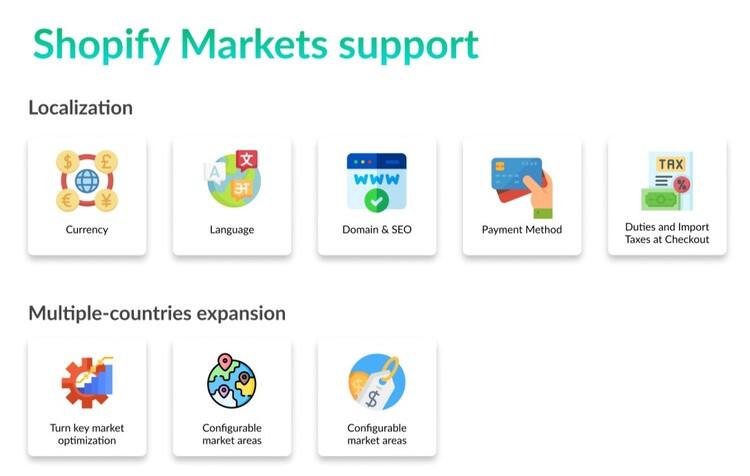
Shopify Markets allows you to manage and expand your global sales with tools for international selling.
By using Shopify Markets, you can create tailored shopping experiences for different types of buyers. Moreover, you can simplify your expansion efforts by creating markets that target specific countries or regions, or you can group countries and regions together.
When was Shopify Markets released?
On September 20, 2021, Shopify Markets became available for early access, and on February 11, 2022, the service became generally available.
Shopify Markets fees
Shopify Currency Conversion fees
Shopify currency conversions occur when you accept payments in a currency that differs from the currency you intend to pay out.
You are charged a currency conversion fee when you receive a payment in your customer’s local currency (also called the presentment currency):

- Currency conversion rate - The exchange rate between two currencies. No fee is charged for the conversion (it’s a mid-market rate without any markup). As an example, a USD/EUR conversion rate of 0.95 means that $1 USD is exchanged for €0.95 EUR.
-
Currency conversion fee - Shopify charges you to convert currencies when you capture payments. On the other hand, refunds don’t return currency conversion fees or credit card fees. However, refunds and chargebacks don’t incur additional conversion fees. The conversion fee is based on your store’s primary country:
- 1.5% in the US
- 2% in all other countries and regions with Shopify Payments
Your payout details include the currency conversion rate and fee. Once the fee is calculated, it is included in your customer’s price.
Shopify Duty and Import tax transaction fees
A transaction fee applies to orders that have duties and import taxes calculated. The amount of this fee depends on whether you use Shopify Payments or a third-party payment provider.
- Shopify Payments charges a 0.85% transaction fee for orders with duties and import taxes. Shopify Payments also charges a 0.85% transaction fee for orders made with third-party payment providers, such as PayPal, as long as Shopify Payments is the primary payment method.
- A 1.5% transaction fee applies to orders that have duties and import taxes for stores that use other payment providers as their gateway. Additionally, Shop Pay’s accelerated checkout fee of 1.5% applies to stores that do not use Shopify Payments as their primary gateway.
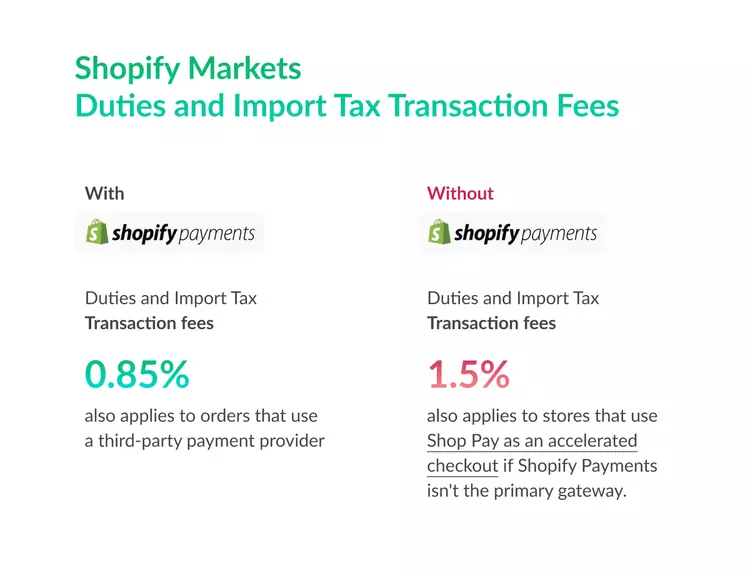
Even if the calculated amount is zero, a transaction fee is charged for every order that has duties and import taxes calculated at checkout. In the following cases, transaction fees are not charged:
- Shipments to the same country or region as the store
- Orders that are shipped between EU member countries
- Abandoned checkouts
Shopify Payments fee
A Shopify Payments fee is charged when you capture the payment for an order. Depending on the type of credit card used (for example, a VISA card may have a different fee than an American Express card) and the location where the card is registered, the fee may be as follows:
- Payment processing fees (Domestic) - Costs associated with processing credit cards issued in your country or region.
- Payment processing fees (Cross border) - Charges for processing credit cards issued in countries or regions other than the one in which the store is located (additional 1%).
Third-party transaction fees
When you use a third-party payment provider to collect customer payments, you will be charged a third-party transaction fee for each transaction. Shopify charges transaction fees based on the Shopify pricing plan that you choose to integrate with external payment providers.
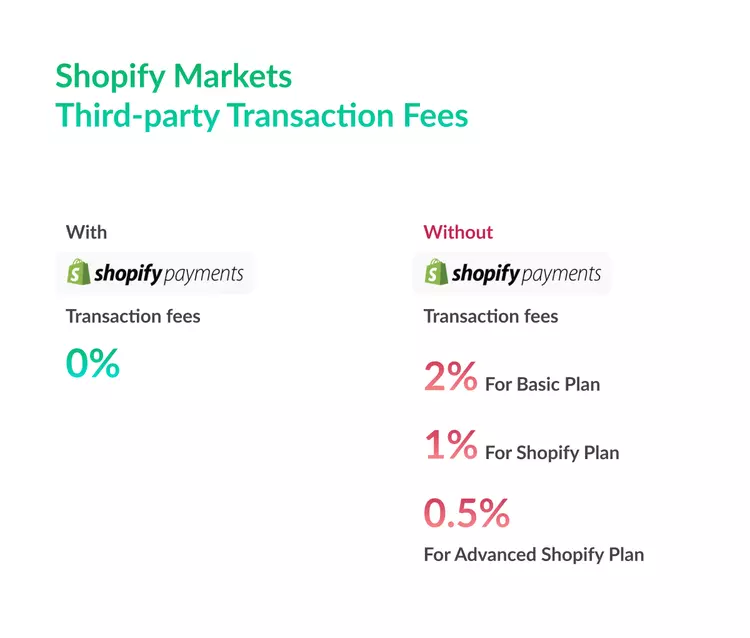
When you use Shopify Payments, you aren’t charged third-party transaction fees for orders that are processed through Shopify Payments, Shop Pay, Shop Pay Installments, and Paypal Express, and you aren’t charged transaction fees on manual payment methods such as cash, cash on delivery (COD), and bank transfers.
Shopify Plus merchants using Shopify Payments pay no transaction fees, except for merchants in Austria, Belgium, and Sweden.
Shopify Markets Fee Calculation
For an order of 100$:
- With Shopify Payment: The total fee will be 6.25$
- Without Shopify Payment: The total fee will be 7.9$
However, the additional fee for an international order is approximately $2.35 - $3.25 in comparison to a domestic order (for example, in this case, it is $100 per order). You can always configure your product pricing to cover these costs!
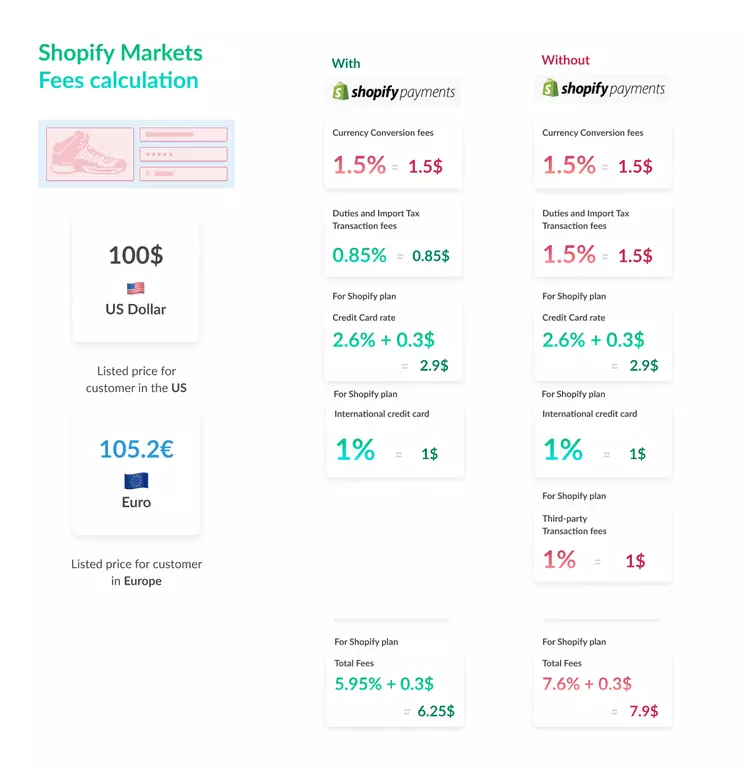
Who should use Shopify Markets?
Countries available for Shopify Markets
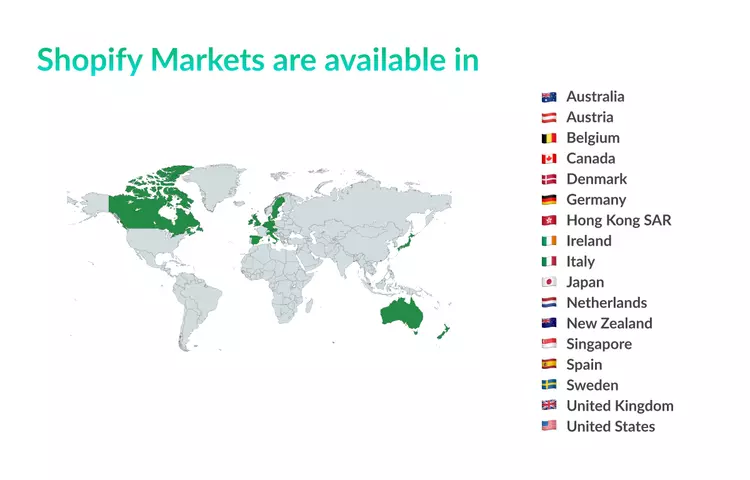
Shopify Markets is currently available to merchants in the following countries:
- Australia
- Austria
- Belgium
- Canada
- Denmark
- Germany
- Hong Kong SAR
- Ireland
- Italy
- Japan
- Netherlands
- New Zealand
- Singapore
- Spain
- Sweden
- United Kingdom
- United States
However, the list is expanding quickly. And will be available for customers all around the world.
At the moment, Shopify Markets has already supported 130+ local currencies, and we will update this article whenever there is a change.
Niches that are suitable for Shopify Markets
You should use Shopify Markets to grow your business if you are selling tangible products like:
- Home decor and furniture
- Gaming products
- Phone Accessories
- Fashion Products
- Electronic Products
- Hobby Products
- Print-on-demand products
- Kitchen accessories
- Pet Products
- Digital Products
- And many more
Shopify Markets might not be ideal for selling foods or services due to the extended global shipping time.
On the other hand, your product might face different legal approaches from different countries, but a little bit of research should help.
How to start selling globally with Shopify Markets?
You are going international, and soon enough, you will have to face the following problems - But don’t worry, Shopify Markets have features that will help you tackle them.
Local currencies
Shopify’s research shows that stores that price their products in a customer’s local currency increase their conversion rates by up to 40%.
With Shopify Payments, Shopify Markets allows you to automatically convert your storefront prices to 130+ international currencies and round them up according to the latest foreign exchange rates.
Moreover, Shopify Markets provides a consistent multi-currency experience throughout the entire shopping process, allowing your customers to shop with confidence wherever they are.
Store translation to local languages
With Shopify Markets, you can translate your store using both Shopify translation and third-party translation apps.
Similar to currencies, with languages, your customers can have a localized experience across your whole store.

And it works wonderfully! A survey of 8,709 global consumers in 29 countries found that 75% prefer online content in their language, and 40% won’t purchase from sites in other languages.
Shopify data also showed that there was a 13% increase in conversion for buyers who were shown a store in their language instead of the default one.
Domains and SEO
Shopify Markets makes it easy to create region-specific domain strategies by automatically creating subfolders when you create a new market.
In this case, example.com can be the address for your US market, while example.com/en-ca can be used for your Canadian market.
Alternatively, you can set up a subdomain (ca.example.com) or a country domain (example.ca) as per your preference.
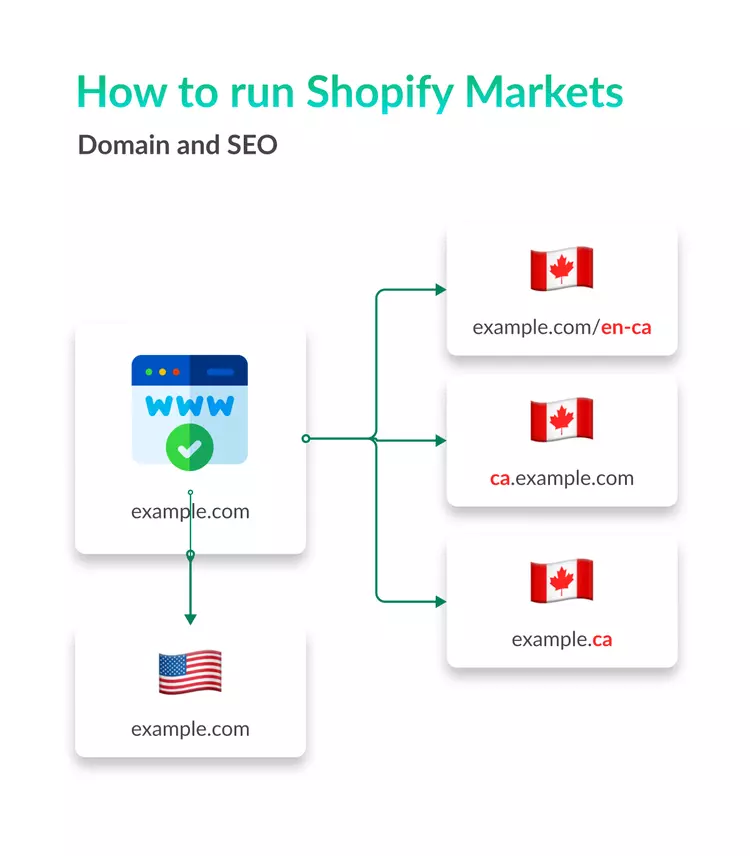
No matter what you choose, Shopify automatically sets the correct SEO tags for your international buyers so they can see the right domain when searching for your business.
Whenever auto-redirects do not work as intended (such as in the EU, where it is not allowed to automatically redirect visitors), the Geolocation app can prompt the customer to select the correct market.
Payment methods
It is important to note that online payment methods can significantly influence buying decisions. Depending on the region, some customers prefer to use services they recognize and trust, which may vary from country to country.
Providing your international customers with local payment methods can have a significant impact on conversion rates.
According to Internet Payments from the Perspective of Retailers and Consumers (a study from ECC Köln), 50% of customers said they had canceled a purchase due to a lack of an acceptable payment method.
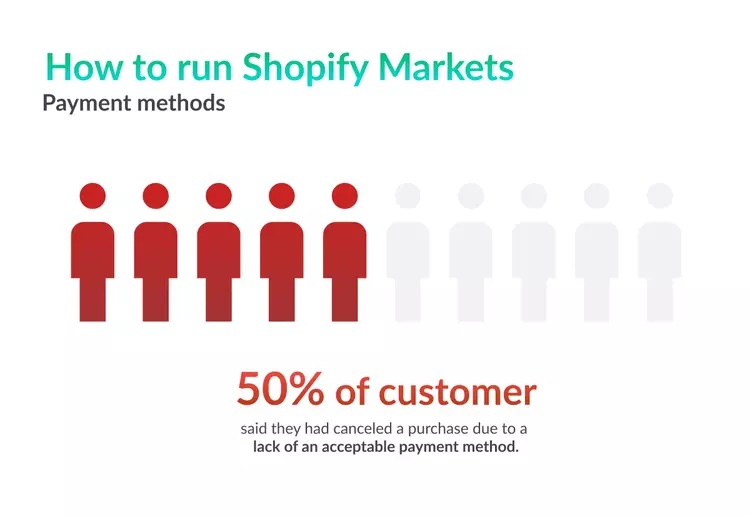
By adding major European payment methods to your checkout, Markets makes it easy to reduce abandoned carts when using multiple currencies.
Duties and import taxes at checkout
International customers may not know whether additional duties, import taxes, or other fees will apply to their purchase, resulting in a less-than-ideal customer experience, parcel refusals, and chargebacks. As such, duties and import taxes are an important part of your international strategy.
With Shopify Markets, international customers are able to have a positive experience with your business by collecting duties and import taxes at the time of checkout. By doing so, your customers will have complete knowledge of their purchase costs and will experience fewer surprises during the delivery process.
Turn-key market optimization
Shopify Markets automates the process of international expansion by automatically implementing the appropriate currency and domain subfolder when you create a new market.
The purpose of this is to ensure that your international customers can find you online and browse in the currency they are most likely to convert into. Additionally, data-driven recommendations help you enter the most viable markets strategically and efficiently so that you can ensure your success.
Configurable market areas
Shopify Markets lets you organize your international business in a way that makes sense for you.
Your business may benefit from managing multiple countries or regions collectively rather than individually, allowing you to expand more broadly without duplicate localization efforts.
Consider, for example, creating a single market for all of Europe or Asia Pacific (don’t worry; you can still present prices in local currencies with local payment methods to your buyers in those regions).
Custom pricing by market
One size does not fit all, and the pricing strategy that is successful in your primary market is unlikely to be successful in every market you wish to expand into.
With Markets, you can adjust your store’s profit in international regions to account for different shipping costs, and you can make quick percentage-based adjustments by market. Shopify Markets also allows you to set specific prices for certain products based on your agreements with resellers or retailers in different regions.





